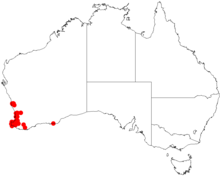Acacia obovata
| Acacia obovata | |
|---|---|
| Scientific classification | |
| Kingdom: | Plantae |
| Clade: | Tracheophytes |
| Clade: | Angiosperms |
| Clade: | Eudicots |
| Clade: | Rosids |
| Order: | Fabales |
| Family: | Fabaceae |
| Subfamily: | Caesalpinioideae |
| Clade: | Mimosoid clade |
| Genus: | Acacia |
| Species: | A. obovata
|
| Binomial name | |
| Acacia obovata Benth. | |

| |
| Occurrence data from AVH | |
Acacia obovata is a shrub belonging to the genus Acacia and the subgenus Phyllodineae that is endemic to south western Australia.
Description
The erect dense shrub typically grows to a height of 0.3 to 0.6 metres (1.0 to 2.0 ft).
Taxonomy
The species was first formally described by the botanist George Bentham in 1842 as a part of William Jackson Hookers' work Notes on Mimoseae, with a synopsis of species as published in the London Journal of Botany. It was reclassified as Racosperma obovatum by Leslie Pedley in 2003 then transferred back to genus Acacia in 2006.[3]
Distribution
It is native to a scattered area along the west coast in the
See also
References
- ^ Department of Biodiversity, Conservation and Attractions.
- ^ a b c "Acacia obovata". World Wide Wattle. Western Australian Herbarium. Retrieved 19 May 2019.
- ^ "Acacia obovata Benth". Atlas of Living Australia. Global Biodiversity Information Facility. Retrieved 19 May 2019.
